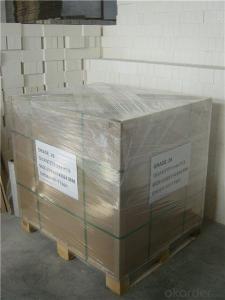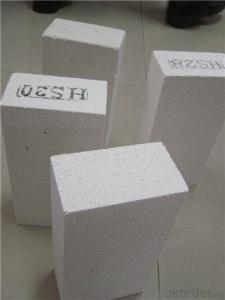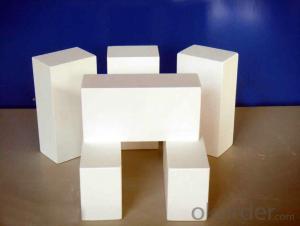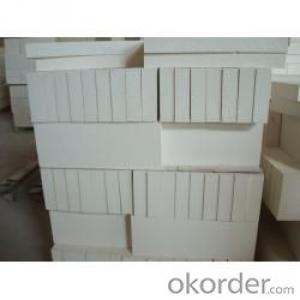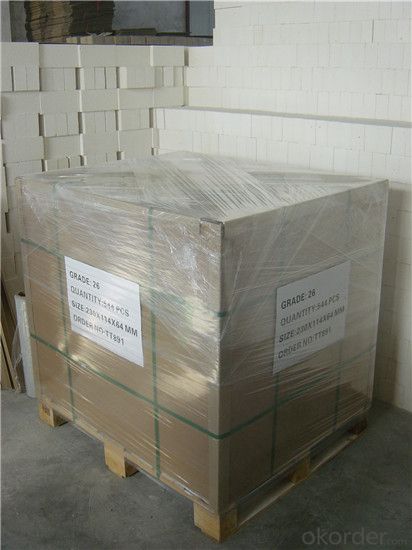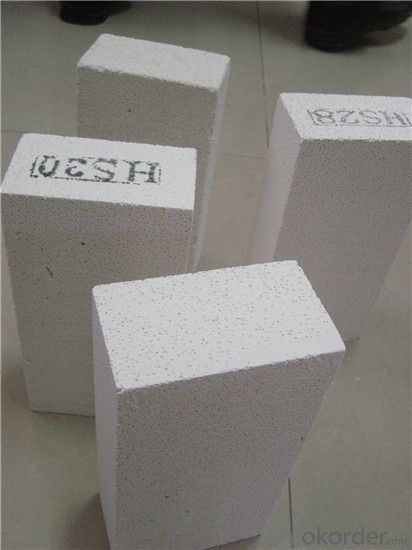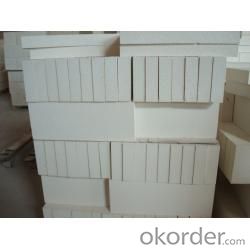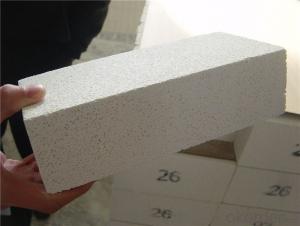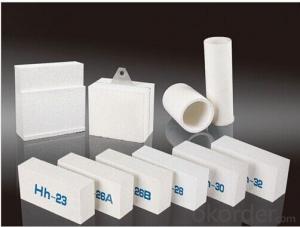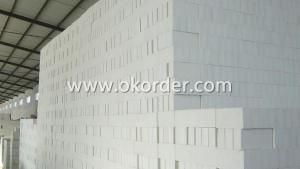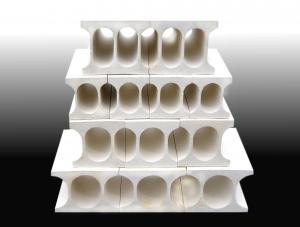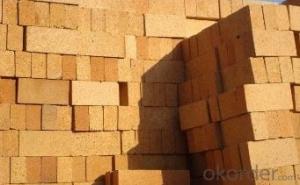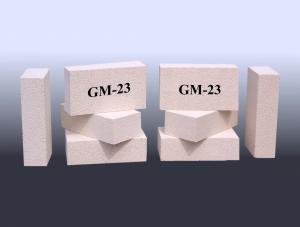High-Quality Insulating Fire Brick - Sintered Mullite Fire Lining Brick
- Loading Port:
- Tianjin
- Payment Terms:
- TT or LC
- Min Order Qty:
- 3 m.t.
- Supply Capability:
- 1000 m.t./month
OKorder Service Pledge
OKorder Financial Service
You Might Also Like
Thermal Insulation Fire Clay Brick
CNBM conforms strictly to the requirements of ISO 9000 quality control system during the production. MSDS is also available if you want. The thermal insulation fire clay brick meet with the requirements of ASTM & JIS standards. So please stay cool with our quality.
Application
Insulating Fire Brick are used for the lining of converter, alternating current arc furnace, direct Current arc furnace and the ladle slag line, etc.
Company Advantage
(1)Long Insulating Fire Brick manufacture history: 25 years manufacturer
(2)Advanced equipment
(3)Diversification of production standards: ISO ANSI FEPA JIS ASTM
(4)Flexible payment: T/T L/C D/P D/A
(5)Professional marketing team and after-sale service
(6)Free sample
Insulating Fire Brick main feature:
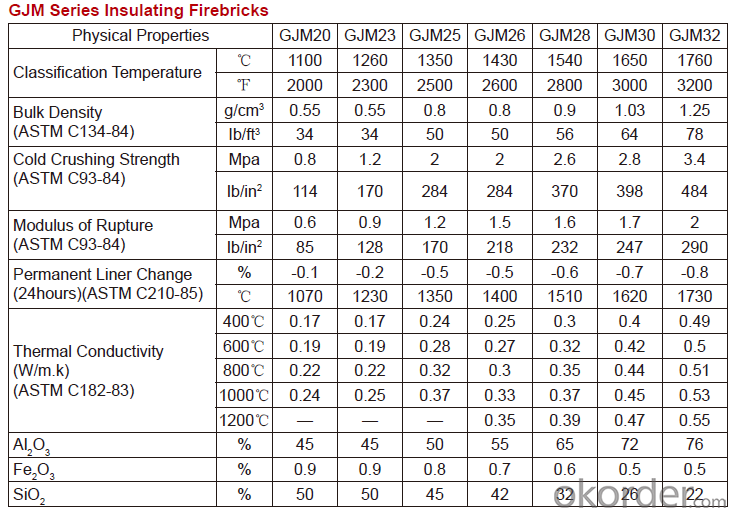
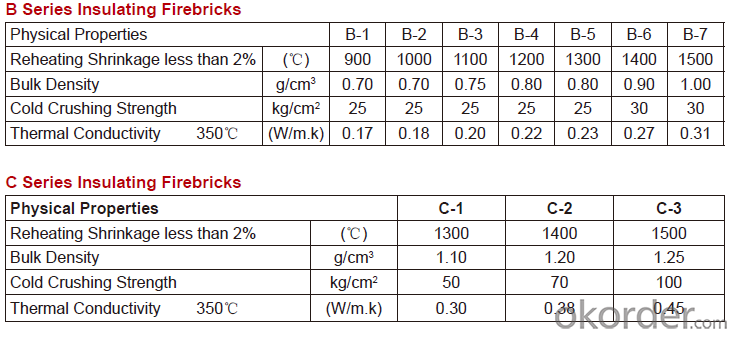
Equipment
1 unit of Ceramic Abrasive (SG Abrasive) pilot production line
2 units of Compact grain Abrasive pilot production lines
1 unit of high-end coated abrasives (abrasive cloth) production line
2 units of Boron Carbide production lines
3 large flexible crushing and sieving lines for grit production lines
2 units of 2000KVA furnaces for Boron Carbide fusion
6 units of 5000KVA-10000KVA dumping type electric arc furnaces for Brown Fused Alumina fusion
FAQs
Q1 What’s the transport method?
A1 FCL delivery goods with wooden pallet or wooden case by sea; If LCL delivery, must with wooden case; Sometimes need open top, flat rack or bulk cargo.
Q2 What’s the required payment term?
A2 Generally 30% TT as the prepayment, 70% TT before delivery. If need, 100% Irrevocable Letter of Credit or negotiation.
Q3 Which country are our products exported to?
A3 Apart from entire Chinese market, the US, Russia, Japan, Korea, Australia and some Southeast Asian Nations.
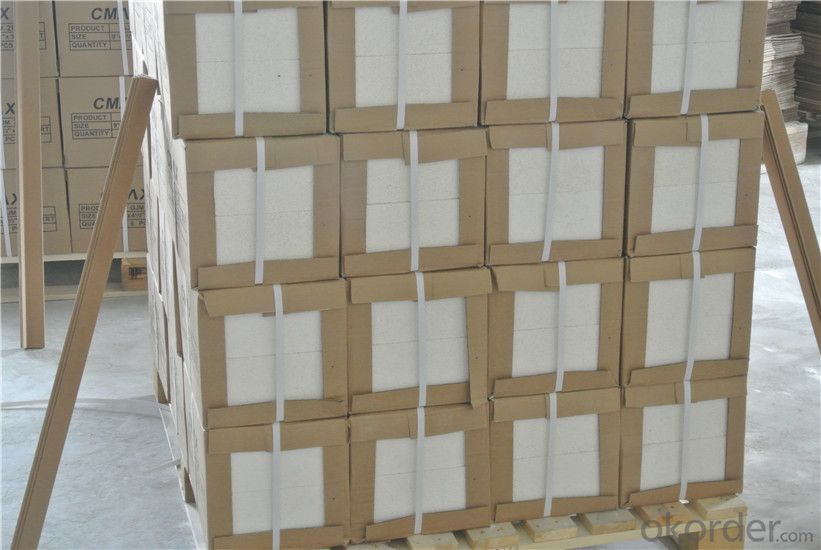
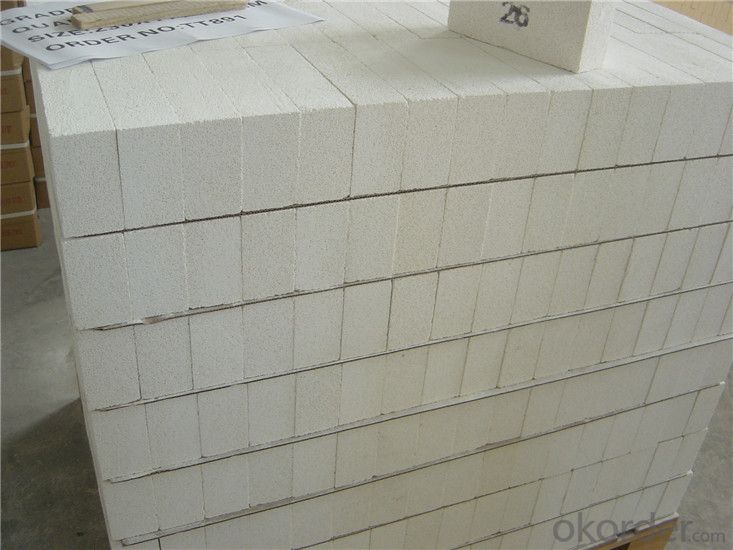
- Q: Can insulating fire bricks be used in refractory cement?
- Yes, insulating fire bricks can be used in refractory cement. Insulating fire bricks are specifically designed to withstand high temperatures and provide excellent insulation, while refractory cement is used to bind and seal refractory materials. By using insulating fire bricks in refractory cement, it can enhance the overall insulation properties and improve the performance of the cement in high-temperature applications.
- Q: Can insulating fire bricks be used to line industrial boilers?
- Industrial boilers can be lined with insulating fire bricks, which have low thermal conductivity and can minimize heat loss and enhance energy efficiency. These bricks, made of lightweight materials like clay and alumina, possess excellent insulation properties. By lining the boiler's interior with these bricks, the heat generated during combustion can be contained, resulting in greater heating efficiency and decreased fuel consumption. Moreover, these bricks are capable of withstanding high temperatures and thermal shocks, making them ideal for the challenging conditions commonly found in industrial boilers. Overall, utilizing insulating fire bricks as lining material can lead to improved energy efficiency, reduced operating expenses, and enhanced durability of the boiler system.
- Q: Are insulating fire bricks suitable for thermal insulation in boilers?
- Insulating fire bricks prove to be a suitable option for thermal insulation in boilers. They are specifically engineered to possess exceptional insulating abilities, enabling them to efficiently diminish heat transfer in environments with high temperatures, like boilers. These bricks are crafted from lightweight materials and possess a low thermal conductivity, thus rendering them highly suitable for applications related to thermal insulation. By incorporating insulating fire bricks in boilers, energy efficiency can be enhanced by minimizing heat loss and ensuring optimal utilization of the boiler-generated heat. Moreover, these bricks exhibit remarkable resistance to elevated temperatures and can endure the harsh conditions prevalent within a boiler, thereby establishing themselves as a dependable choice for thermal insulation.
- Q: Are insulating fire bricks resistant to ammonia gas?
- Insulating fire bricks, in general, lack resistance against ammonia gas. Although these bricks are engineered to endure elevated temperatures and offer thermal insulation, they are commonly constructed from lightweight refractory materials, like clay or silica, which are not particularly resilient to corrosive substances such as ammonia gas. Over time, ammonia gas can react with these materials and result in deterioration or harm to the bricks. Consequently, if you require fire bricks for an environment containing ammonia gas, it is advisable to opt for specially designed acid-resistant or chemical-resistant bricks that can endure the corrosive impact of ammonia gas.
- Q: Are insulating fire bricks resistant to abrasion or wear?
- Insulating fire bricks possess resistance to abrasion and wear. These bricks are crafted using top-notch refractory materials, like alumina or silica, that exhibit exceptional resistance to abrasion. Through the manufacturing process, the bricks are subjected to high-temperature firing, which enhances their durability and fortifies them. Insulating fire bricks are explicitly engineered to endure the demanding conditions found in high-temperature applications such as furnaces, kilns, and fireplaces. They exhibit high resistance to thermal shock, chemical erosion, and mechanical wear. As a result, they serve as a dependable option for insulating and safeguarding the inner walls of these structures, thereby ensuring long-lasting performance and reducing the need for frequent replacements.
- Q: Can insulating fire bricks be used for insulation in flues?
- Yes, insulating fire bricks can be used for insulation in flues. These bricks are designed to withstand high temperatures and provide excellent thermal insulation, making them suitable for lining and insulating flue systems. They help to prevent heat loss, improve energy efficiency, and enhance the overall performance of the flue.
- Q: Can insulating fire bricks be used in refractory linings for blast furnaces?
- Yes, insulating fire bricks can be used in refractory linings for blast furnaces. Insulating fire bricks are designed to have low thermal conductivity, which means they can effectively reduce heat loss from the furnace. This property is particularly important in blast furnaces, where maintaining high temperatures is essential for efficient operation. Insulating fire bricks are made from lightweight refractory materials such as alumina or silica, which have high insulating properties. These bricks not only provide thermal insulation but also have good resistance to thermal shock, making them suitable for the extreme conditions found in blast furnaces. In addition to insulation, insulating fire bricks also offer other advantages for blast furnace linings. They are lightweight and easy to install, which reduces the labor and time required for construction. Furthermore, their low thermal conductivity can help to minimize the formation of hot spots and uneven temperature distribution within the furnace, which can lead to premature wear and failure of the refractory lining. However, it's important to note that insulating fire bricks alone may not be sufficient for all parts of the blast furnace lining. Certain areas, such as the hearth and tuyere zones, may require high-density refractory bricks that can withstand the intense heat and mechanical stress. In these cases, a combination of insulating fire bricks and other refractory materials may be used to achieve the desired performance and longevity. Overall, insulating fire bricks can be a valuable component in refractory linings for blast furnaces, helping to improve energy efficiency, reduce heat loss, and prolong the lifespan of the lining.
- Q: Are insulating fire bricks resistant to reducing atmospheres?
- Yes, insulating fire bricks are resistant to reducing atmospheres.
- Q: Are insulating fire bricks resistant to thermal spalling?
- Insulating fire bricks exhibit resistance to thermal spalling, which is the process of a material cracking or fracturing as a result of abrupt fluctuations in temperature or thermal shock. These bricks are specifically engineered to endure elevated temperatures and thermal cycling without spalling. Their low thermal conductivity allows for efficient insulation against heat transfer, thereby reducing the strain caused by thermal expansion and contraction. Moreover, the composition and structure of insulating fire bricks are meticulously designed to offer outstanding protection against thermal spalling, rendering them a dependable option for applications involving intense heat conditions.
- Q: Are insulating fire bricks resistant to vibrations?
- Insulating fire bricks are generally not designed to be resistant to vibrations. While they are known for their excellent thermal insulation properties, their resistance to vibrations is typically limited. Insulating fire bricks are made from lightweight materials such as ceramic fibers, vermiculite, or perlite, which are not particularly known for their ability to dampen or absorb vibrations. Therefore, if a specific application requires resistance to vibrations, it may be advisable to consider alternative materials or designs that are better suited for such conditions.
Send your message to us
High-Quality Insulating Fire Brick - Sintered Mullite Fire Lining Brick
- Loading Port:
- Tianjin
- Payment Terms:
- TT or LC
- Min Order Qty:
- 3 m.t.
- Supply Capability:
- 1000 m.t./month
OKorder Service Pledge
OKorder Financial Service
Similar products
Hot products
Hot Searches
Related keywords
